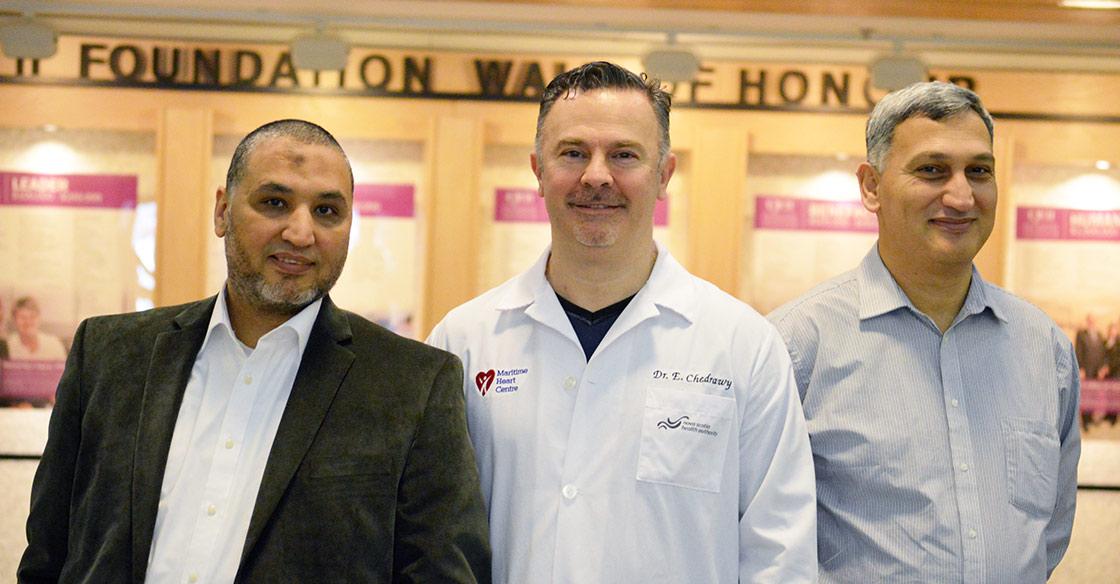
ERAS is a multidisciplinary care improvement approach to how patients recover from surgery. - Dr. Edgar Chedrawy
New cardiac surgery approach changing care for patients at the QEII
Originally published on qe2times.ca.
A team of healthcare professionals at the QEII Health Sciences Centre is applying a comprehensive new strategy for cardiac surgery called ERAS — Enhanced Recovery After Surgery.
“ERAS is a multidisciplinary care improvement approach to how patients recover from surgery,” says Dr. Edgar Chedrawy, head of cardiac surgery at the QEII and an associate professor in the Department of Surgery at Dalhousie University.
As Dr. Chedrawy explains, ERAS is designed to prepare and guide cardiac patients through every stage of their procedure.
“Prior to surgery, we assess patients from a nutritional standpoint and we check the medications they’re currently taking,” he explains.
The ERAS team also performs a series of “engagement and pre-habilitation” measures, which are designed to improve the candidate’s functional capacity. “This helps patients to better deal with the stress of surgery,” says Dr. Chedrawy.
Another major part of ERAS is addressing the patient’s anxiety. As cardiac surgeon Dr. Hashem Aliter explains, this is accomplished by making social workers available for counselling and demystifying the process via an informational booklet, as well as a series of informative videos.
“This allows the patient and their family to know the expectations, such as physiotherapy, nutrition and activity at home,” he says.
According to anesthesiologist Dr. Ayman Hendy, the tradition of fasting before surgery has also been challenged.
“We now allow patients to drink clear fluids and consume specific carbohydrates,” he says. “The body can preserve it’s proteins for healing and other important functions.”
This level of care continues into the procedure itself.
“We implement different measures to help monitor the patient’s body temperature, control their blood sugar and reduce their chances of bleeding,”says Dr. Chedrawy.
With the stress of surgery elevating the patient’s glucose levels and, in turn, increasing their chance of infection, strict temperature and sugar controls are enacted.
“We also treat the patient’s pain and post-surgery delirium much more aggressively,” adds Dr. Chedrawy.
As Dr. Hendy points out, the historical use of powerful opioids for pain mitigation could be problematic, since they often render patients completely uncommunicative.
“By using shorter-acting pain medications, the patient’s mind is clearer faster after surgery,” he says. “Now, they can be given instructions and quantify their pain experience.”
Applying local anesthetics for targeted nerve blocks also helps to cut down on the use of debilitating painkillers. “This way, we can freeze the area and not give the patient something that makes their mind foggy,” says Dr. Hendy.
This cumulative level of care also gives the ERAS team a chance to liberate patients from the restrictive surgical tubing used to drain any blood accumulating after cardiac surgery, a lot sooner. Not only does this reduce pain and the threat of obstruction or infection, but it also gives patients back their mobility much sooner which, in turn, expedites their release from hospital.
“Almost a third of our patients will have some sort of kidney or lung injury, which is a potential side effect of the heart-lung machine used during surgery,” says Dr. Chedrawy. “While temporary and reversible, this injury prolongs their intubation time and their length of stay after surgery. But ERAS reduces that by almost 25 to 30 per cent.”
“We wait three or four hours and if the patient is stable, we remove the breathing tube and start with early mobilization if the patient’s condition permits,” says Dr. Aliter.
Hydration and the early stabilization of body functions is another key component in the ERAS recovery process.
“We start with a clear fluid four to six hours after removing the breathing tube and we give them chewing gum if their condition permits,” says Dr. Aliter. “This will help normalize their gastrointestinal system after surgery and help prevent any further complications.”
As soon as it becomes feasible, light physical activity is encouraged.
“We get patients to use an incentive spirometer as soon as possible, even before surgery,” Dr. Aliter explains. “It’s a device designed to improve their lungs and respiratory function, so it’s easier for us to discharge them home.”
The QEII is the only medical site in Atlantic Canada to feature a cardiac surgery ERAS program. As such, it brings together a unique and talented pool of personnel from such diverse disciplines as anesthesia, nursing, social work, cardiology, pharmacy, nutrition and physiotherapy.
“It’s been shown many times to have an overall reduction in complication rates and length of stay, as well as an improvement in cost and the patient experience,” says Dr. Chedrawy.
“When the patient goes home, they’re in stable condition, they’re feeling well and everything is taken care of,” adds Dr. Aliter.